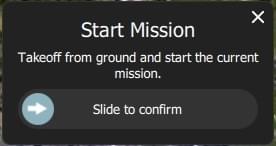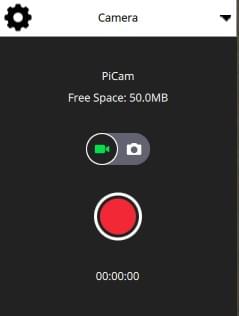Fly View
The Fly View is used to command and monitor the vehicle.
Overview

- Toolbar: The toolbar is at the top of the screen. It provides controls to select views, show flight status and mode as well as the status of the main components of the vehicle.
- Vehicle Actions: Allows you command the vehicle to take a specific action.
- Instrument Panel: A widget that displays vehicle telemetry.
- Attitude/Compass: A widget that provides virtual horizon and heading information.
- Camera Tools: A widget for switching between still and video modes, starting/stopping capture, and controlling camera settings.
- Video: Display the video from the vehicle. Allows you to toggle between video or map as the main display.
- Map: Displays the positions of all connected vehicles and the mission for the current vehicle.
There are a number of other elements that are not displayed by default and are only displayed in certain conditions or for certain vehicle types.
Actions/Tasks
The following sections describe how to perform common operations/tasks in the Fly View.
INFO
Many of the available options depend on both the vehicle type and its current state.
Actions associated with a map position (#map_actions)
There are a number of actions which can be taken which are associated with a specific position on the map. To use these actions:
- Click on the map at a specific position
- A popup will display showing you the list of available actions
- Select the action you want
- Confirm the action
Examples of map position actions are Go To Location, Orbit and so forth.
Pause
You can pause most operations, including taking off, landing, RTL, mission execution, orbit at location. The vehicle behaviour when paused depends on the vehicle type; typically a multicopter will hover, and a fixed wing vehicle will circle.
INFO
You cannot pause a Goto location operation.
To pause:
- Press the Pause button in the Fly Tools.
- Optionally set a new altitude using the right-side vertical slider.
- Confirm the pause using the slider.
Missions
Start Mission
You can start a mission when the vehicle is landed (the start mission confirmation slider is often displayed by default).
To start a mission from landed:
Press the Action button on the Fly Tools
Select the Start Mission action from the dialog.

(to display the confirmation slider)
When the confirmation slider appears, drag it to start the mission.

Continue Mission
You can continue mission from the next waypoint when you're flying (the Continue Mission confirmation slider is often displayed by default after you takeoff).
INFO
Continue and Resume mission are different! Continue is used to restart a mission that has been paused, or where you have taken off, so you've already missed a takeoff mission command. Resume mission is used when you've used a RTL or landed midway through a mission (e.g. for a battery change) and then wish to continue the next mission item (i.e. it takes you to where you were up to in the mission, rather than continuing from your place in the mission).
You can continue the current mission while (unless already in a mission!):
Press the Action button on the Fly Tools
Select the Continue Mission action from the dialog.

Drag the confirmation slider to continue the mission.

Resume Mission
Resume Mission is used to resume a mission after performing an RTL/Return or Land from within a mission (in order, for example, to perform a battery change).
INFO
If you are performing a battery change, do not disconnect QGC from the vehicle after disconnecting the battery. After you insert the new battery QGroundControl will detect the vehicle again and automatically restore the connection.
After landing you will be prompted with a Flight Plan complete dialog, which gives you the option to remove the plan from the vehicle, leave it on the vehicle, or to resume the mission from the last waypoint that was traveled through.

If you select to resume the mission, then QGroundControl will rebuild the mission and upload it to the vehicle. Then use the Start Mission slider to continue the mission.
The image below shows the mission that was rebuilt after the Return shown above.

INFO
A mission cannot simply resume from the last mission item that the vehicle executed, because there may be multiple items at the last waypoint that affect the next stage of the mission (e.g. speed commands or camera control commands). Instead QGroundControl rebuilds the mission, starting from the last mission item flown, and automatically prepending any relevant commands to the front of the mission.
Remove Mission Prompt After Landing
You will be prompted to remove the mission from the vehicle after the mission completes and the vehicle lands and disarms. This is meant to prevent issues where stale missions are unknowingly left on a vehicle, potentially resulting in unexpected behavior.
Display Video
When video streaming is enabled, QGroundControl will display the video stream for the currently selected vehicle in the "video switcher window" at the bottom left of the map. You can press the switcher anywhere to toggle Video and Map to foreground (in the image below, the video is shown in the foreground).

INFO
Video streaming is configured/enabled in Application Settings > General tab > Video.
You can further configure video display using controls on the switcher:

- Resize the switcher by dragging the icon in the top right corner.
- Hide the switcher by pressing the toggle icon in the lower left.
- Detach the video switcher window by pressing on the icon in its top left corner (once detached, you can move and resize the window just like any other in your OS). If you close the detached window the switcher will re-lock to the QGC Fly view.
Record Video
If supported by the camera and vehicle, QGroundControl can start and stop video recording on the camera itself. QGroundControl can also record the video stream and save it locally.
TIP
Video stored on the camera may be of much higher quality, but it is likely that your ground station will have a much larger recording capacity.
Record Video Stream (on GCS)
Video stream recording is controlled on the video stream instrument page. Press the red circle to start recording a new video (a new video file is created each time the circle is pressed); the circle will change into a red square while recording is in progress.

Video stream recording is configured in the Application Settings > General tab:
Video Recording - specifies the recording file format and storage limits.
INFO
Videos are saved in Matroska format (.mkv) by default. This format is relatively robust against corruption in case of errors.
Miscellaneous - Streamed video is saved under the Application Load/Save Path.
TIP
The stored video includes just the video stream itself. To record video with QGroundControl application elements displayed, you should use separate screen recording software.
Record Video on Camera
Start/stop video recording on the camera itself using the camera instrument page. First toggle to video mode, then select the red button to start recording.
